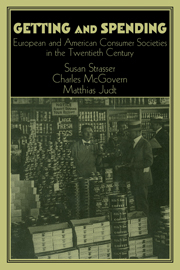Book contents
21 - Reconsidering Abundance: A Plea for Ambiguity
Published online by Cambridge University Press: 05 January 2013
Summary
Attitudes toward ambiguity have a revealing history. Certain people, under certain conditions, tolerate uncertainty better than others. To American intellectuals of the post-World War II era, respect for ambiguity was a sign of emancipation from the sentimental dualisms of the liberal-progressive tradition. For Lionel Trilling and Richard Hofstadter (to mention just two prominent examples), ambiguity was almost always “rich.”
Amid this widespread trend toward ambiguity worship, one intellectual product of the era remains a puzzling anomaly: David Potter's People of Plenty (1954), the book that has virtually defined economic abundance for Americanists. Potter was a contemporary of Hofstadter - indeed they formed a mutual admiration society - and the author of some extraordinarily nuanced interpretations of the Civil War and (white) southern culture. One might imagine him a plausible devotee of ambiguity.
Yet Potter's description of American abundance was anything but ambiguous. It was absolutely straightforward. Potter noted the extraordinary availability of natural resources, as well as the advanced technology, fluid society, and enterprising spirit that allowed Americans to transform those resources into the raw materials of economic development; the result of that development, in his view, was a huge and growing pile of mass-produced things. That was American abundance. Americans were a people of plenty because they had lots of stuff. Their relation to things was unproblematic: They liked things and wanted more.
- Type
- Chapter
- Information
- Getting and SpendingEuropean and American Consumer Societies in the Twentieth Century, pp. 449 - 466Publisher: Cambridge University PressPrint publication year: 1998
- 2
- Cited by



